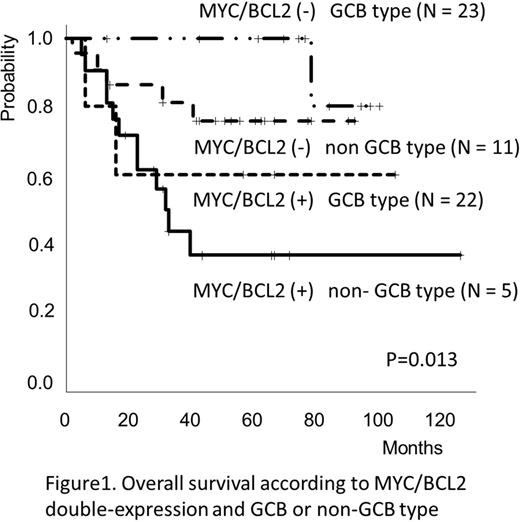Abstract
Background:
Diffuse large B-cell lymphoma, not other specified (DLBCL, NOS) is the most common type of malignant lymphoma and accounts for approximately one-third of all non-Hodgkin lymphomas. Translocation of MYC, BCL2, and BCL6 genes detected by fluorescence in-situ hybridization (FISH) were found in approximately 10%, 14%, and 20% DLBCL, respectively. MYC translocation is already reported to be an independent poor prognostic factor in DLBCL. Immunohistochemical(IHC) analysis has revealed that concurrent protein expression of MYC and BCL2 could be a predictive factor for overall survival (OS). However, the relationship between translocation and expression of MYC, BCL2 and BCL6 is still unknown, and it is not clear what proportion of MYC and BCL2 IHC is predictive for OS.
Objectives:
The purpose of this study was to clarify the clinical prognostic value of immunostaining and chromosomal translocation of MYC, BCL2 and BCL6 among the populations in whom these results were investigated.
Patients and Methods:
Sixty-one adult patients, newly diagnosed as DLBCL, NOS between October 2003 and October 2012 at Niigata University Hospital, were analyzed retrospectively. MYC, BCL2 and BCL6 rearrangements were detected by FISH, and the expression of MYC, BCL2, and BCL6 proteins were investigated by IHC. To assess the proportion of these proteins, we created a tissue microarray (TMA). The median age was 62 years (range: 17-85 years), and the median follow up period was 42 months (range: 2-127 months). All patients were treated with R-CHOP or R-CHOP-like regimens. OS was estimated by the Kaplan-Meier method. Multivariate Cox regression for OS was used to identify the independent prognostic factors.
Results:
According to univariate analysis, MYC rearrangement (10%) was a prognostic factor (P = 0.026); however, BCL2 and BCL6 translocation were not prognostic indicators (11%, P = 0.899; 13%, P = 0.819, respectively). On the other hand, the expression of MYC detected by IHC showed no statistical significance for OS, even if the cut-off level by MYC and BCL6 immunostaining was modified. However, if we divided the patients into two groups, i.e., those with 0-9% and those with ≥10% expression of BCL2 immunostaining, ≥10% expression of BCL2 may be a prognostic factor (P = 0.0087). We subsequently analyzed whether the concurrent expression of MYC and BCL2 or that of MYC and BCL6 would be prognostic factors for OS. In this study, patients with ≥30% expression of MYC and ≥30% expression of BCL2 showed poor prognosis compared to other patients (P = 0.00234, 5-year OS 42%, 84% respectively). Furthermore, we divided the patients in two groups i.e., the germinal center B-cell-like (GCB) type and non-GCB type as described by Hans et al., and the non-GCB type was observed to be a poor prognostic factor in both groups (P = 0.013). Further, we investigated whether these factors could be independent factors for OS. Multivariate analysis revealed IPI3-5 (HR, 3.1510 [range: 1.181-3.151), P = 0.022), MYC translocation (HR, 3.686 [range: 1.113-12.210], P = 0.033), and MYC (≥30%)/BCL2 (≥30%) double-expression (HR, 4.051 [range: 1.447-11.340], P = 0.0078) were independent poor prognostic indicators in newly diagnosed DLBCL patients treated with R-CHOP or R-CHOP like regimens.
Conclusions
MYC translocation by FISH and MYC (≥30%)/BCL2 (≥30%) double-expression detected by IHC could be independent prognostic factors for OS. However, MYC expression is not a surrogate marker for MYC translocation by FISH. In conclusion, FISH analysis of MYC translocation and MYC and BCL2 co-expression are important for predicting the prognosis of DLBCL. These results indicate that further validation is required using another population.
No relevant conflicts of interest to declare.
Author notes
Asterisk with author names denotes non-ASH members.



This feature is available to Subscribers Only
Sign In or Create an Account Close Modal